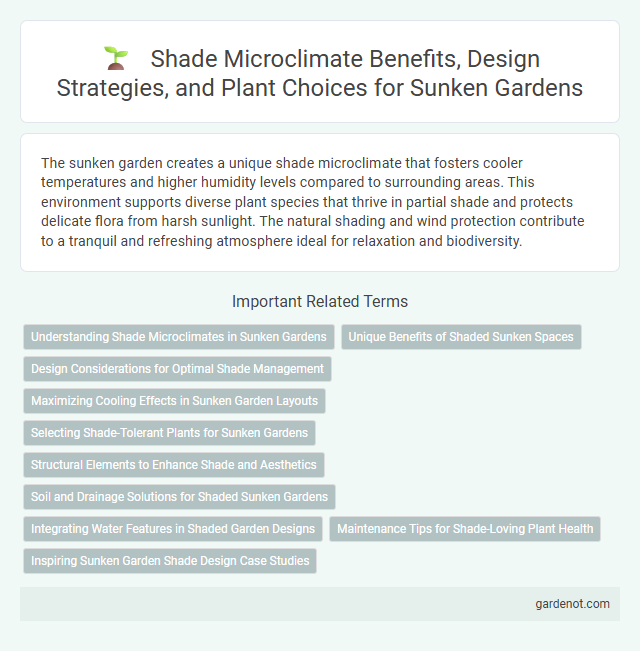The sunken garden creates a unique shade microclimate that fosters cooler temperatures and higher humidity levels compared to surrounding areas. This environment supports diverse plant species that thrive in partial shade and protects delicate flora from harsh sunlight. The natural shading and wind protection contribute to a tranquil and refreshing atmosphere ideal for relaxation and biodiversity.
Understanding Shade Microclimates in Sunken Gardens
Shade microclimates in sunken gardens create unique environmental conditions with lower temperatures and higher humidity compared to surrounding areas, promoting the growth of shade-tolerant plants like ferns and hostas. The sunken design reduces direct sunlight exposure while enhancing moisture retention, which supports delicate understory vegetation and improves biodiversity. Understanding these localized microclimate factors is essential for selecting appropriate plant species and optimizing garden health and aesthetics.
Unique Benefits of Shaded Sunken Spaces
Shaded sunken gardens create a distinct microclimate by reducing direct sunlight and lowering temperatures, which promotes cooler and more comfortable environments. The natural shelter from wind and heat helps preserve soil moisture, supporting diverse plant growth and enhancing biodiversity. This unique microclimate fosters a tranquil retreat, improving air quality and encouraging relaxation within urban or residential landscapes.
Design Considerations for Optimal Shade Management
Shade microclimate in a sunken garden is enhanced by strategic placement of large canopy trees and climbing plants to reduce ambient temperature and increase humidity levels. Incorporating layered vegetation and permeable surfaces promotes airflow while minimizing heat accumulation, supporting plant health and visitor comfort. Design considerations include selecting drought-resistant shade species and orienting plantings to maximize natural shading during peak sunlight hours.
Maximizing Cooling Effects in Sunken Garden Layouts
Sunken garden layouts create natural shade microclimates by situating plants and seating areas below ground level, which reduces exposure to direct sunlight and captures cooler air. Strategic placement of deciduous trees and pergolas enhances evapotranspiration, increasing humidity and lowering ambient temperature within the sunken space. Using materials with high thermal mass such as stone walls helps absorb and slowly release heat, maximizing cooling effects and improving comfort in hot climates.
Selecting Shade-Tolerant Plants for Sunken Gardens
Sunken gardens often create unique shade microclimates characterized by cooler temperatures and reduced sunlight exposure, making them ideal for shade-tolerant plants. Selecting species such as hostas, ferns, and astilbes thrives in these damp, shaded environments by maximizing moisture retention and minimizing heat stress. Incorporating diverse shade-loving plants enhances the sunken garden's ecological balance and aesthetic appeal.
Structural Elements to Enhance Shade and Aesthetics
Structural elements such as pergolas, trellises, and lattices are essential to creating a shade microclimate in a sunken garden, providing both cooling relief and visual appeal. Incorporating climbing plants like ivy or wisteria on these structures enhances natural shading while adding texture and color contrast that enriches the garden's aesthetic ambiance. Strategically positioning these elements around seating areas promotes comfort by reducing direct sunlight exposure, thereby optimizing the microclimate for relaxation and extended outdoor enjoyment.
Soil and Drainage Solutions for Shaded Sunken Gardens
Shaded sunken gardens require well-draining, moisture-retentive soil to prevent root rot while maintaining adequate hydration. Incorporating organic matter such as compost and leaf mold improves soil structure, enhances aeration, and supports beneficial microbial activity in low-light conditions. Strategic installation of subsurface drainage systems and raised planting beds ensures excess water is efficiently diverted, promoting healthy root development and mitigating waterlogging in shaded environments.
Integrating Water Features in Shaded Garden Designs
Integrating water features in shaded garden designs enhances the shade microclimate by increasing humidity and cooling the surrounding air, which benefits both plants and visitors. Water elements such as small ponds, fountains, or drip irrigation support shade-loving plant species like ferns, hostas, and mosses by maintaining moisture levels critical for their growth. These features also create soothing sounds and visual interest, making shaded sunken gardens more inviting and ecologically balanced.
Maintenance Tips for Shade-Loving Plant Health
Maintaining a healthy shade microclimate in a sunken garden requires regular monitoring of soil moisture to prevent overwatering and root rot in shade-loving plants. Pruning surrounding trees and shrubs enhances air circulation and light penetration, which supports vigorous plant growth. Applying a layer of organic mulch conserves soil moisture, regulates temperature, and suppresses weeds, promoting optimal health for shade-tolerant species.
Inspiring Sunken Garden Shade Design Case Studies
Sunken garden shade microclimates create cooler, more humid environments by leveraging lower elevation and surrounding walls to reduce direct sunlight and wind exposure. Case studies reveal innovative designs incorporating deciduous trees, pergolas with climbing vines, and textured hardscapes that enhance shade while promoting airflow and plant diversity. These examples demonstrate how strategic shade elements contribute to sustainable garden microclimates, improving comfort and ecological balance.
Shade microclimate Infographic

 gardenot.com
gardenot.com